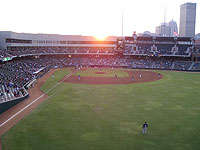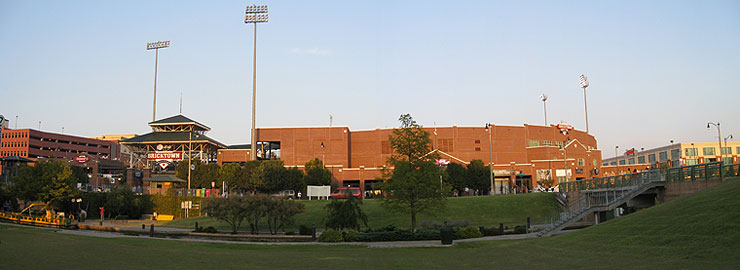
|
For reasons I can’t explain, a significant number of buildings in Oklahoma are built with brick, which explains why 480,000 of them were used in the construction of the aptly named AT&T Bricktown Ballpark, which derives its name from one of the city’s largest employers and the neighborhood that the ballpark’s construction helped to revitalize.
Bricktown, the neighborhood, predated Oklahoma’s statehood (1907) but was largely dilapidated by the time the city funded the $34 million ballpark that would spur its rebirth. Given its location and the popularity of brick masonry construction throughout the state, examples of which include Oklahoma's most prominent sports facilities -- the exteriors of the football stadiums in Norman (Oklahoma) and Stillwater (Oklahoma State) are made of brick and mortar, ditto for the arena used by the NBA’s Oklahoma City Thunder -- it's no surprise that the Bricktown ballpark is made of bricks. Those bricks, reddish in color, are responsible for the “vintage appearance and feel” that the capital city of Oklahoma likes to tout about its ballpark, which was named best in the minors by Minor League News in 2003, five years after it opened.
The ballpark, dubbed “The Brick,” has three entrances and each one is fronted by a statue in their respective plazas, which are named for the native Oklahomans that became national treasures through their hardball feats performed outside of the Sooner State. Mickey Mantle and Warren Spahn are remembered in left and right field respectively, while Johnny Bench is honored in the main entrance behind home plate, an appropriate location for his statue, considering the Oklahoma City-born Bench’s literal position in the game. The focal point of the Johnny Bench Plaza, however, isn’t his 9’ tall statue, which includes an inscription that concludes with the words “a true Oklahoma hero.” Instead, local artist Susan Morrison steals the spotlight with the aid of 158,000 tiles, the amount she needed to make six “History of Bricktown” murals. There are three panels of murals on each of the two brick walls that extend from opposite sides of the home plate entrance gate to frame Bench’s plaza. Shrubbery has been planted in front of Morrison’s mosaic-style artwork, which pays homage to the neighborhood’s history. One mural depicts the city's first Afro-American school, the Douglass School, which for 31 years stood on the land now occupied by AT&T Bricktown Ballpark. For many years, oil wells were widespread throughout Oklahoma City, a result of oil being discovered within city limits in 1928. The wells began to disappear as the oil beneath the city dried up, but baseball-topped derricks have been erected in the plazas in their memory. The home of the Oklahoma City RedHawks does an especially great job at honoring the game's greats that were born or bred (or both) in Oklahoma. Near the Mickey Mantle Plaza are seven busts that were dedicated in conjunction with the state's centennial celebration in 2007. Thanks to the Oklahoma Centennial Commission and various sponsors, the state’s greatest baseball players not named Mantle, Bench or Spahn are remembered outside the ballpark on a tree-lined portion of sidewalk, where from left to right bronze busts of Allie Reynolds, Bobby Murcer, Pepper Martin, Carl Hubbell, Paul Waner, Lloyd Waner and Joe Rogan are placed atop marble bases with etched biographies. Four of those seven players are Hall of Famers and all were born in Oklahoma except Hubbell, who grew up in the state. Perhaps the most famous person ever born in Oklahoma was Mickey Mantle, who started his life in Spavinaw and matured 50 miles from there in Commerce. The two northeastern Oklahoma towns had a combined population of 3,208 in the 2000 US Census and neither city is within 150 miles of 2 South Mickey Mantle Drive, the Oklahoma City address for the Bricktown ballpark that can hold more than four times the combined citizenry of the American icon's birthplace and adolescent residence. While The Mick died three years before the 13,066-seat ballpark on his Drive opened, he has been poignantly remembered with a statue that was dedicated on April 16, 1998, the date of the first game played at Bricktown. The bronze sculpture by Blair Buswell shows Mantle in a classic slugger pose. Circling the statue are handprints in cement, and beneath each set is the signature of the Mantle family member or Yankees teammate to whom the handprints belong. From Yogi Berra to granddaughter Marlyn Mantle, the ring that surrounds Mickey’s statue is a touching tribute in the truest sense of the phase.
While reminders to the past abound inside and out, the prominence of brick is primarily an exterior phenomenon at Oklahoma City's ballpark. Concrete, structural and reinforcement steel aren’t as charming as brick, but those are the dominate materials used inside of The Brick. The two visible exceptions are the sports bar in the left field corner and the hitter’s backdrop in center field, but aside from those two redbrick structures the only red seen inside of the ballpark is the paint applied to all of its railings. Outside the ballpark is a different story, thanks to the nine-story Hampton Inn, which overlooks left field and altered the ballpark’s backdrop when it opened just prior to the 2009 season. The brick-built hotel has 200 rooms and 60 of them, a dozen each on the top five floors, have a bird’s eye view of the playing field. Adjoining the Hampton Inn is the Bricktown Parking Garage and those who pay to park there can watch the game for free from the garage’s upper levels. Those who prefer to watch the ballgame within the ballpark’s confines have plenty of options, as AT&T Bricktown Ballpark is enormous, a mini major league stadium if ever there's one in the minors. It has two decks, a decent-sized berm, plenty of standing room and an ample number of VIP areas. The majority of seats in Oklahoma City's ballpark are found in the symmetrical lower bowl, which can accommodate 7,500. There are 21 seating sections in the lower level. The last three sections on each side contain bleachers with seatbacks; the fifteen sections they bookend are filled with the standard issue stadium-style seats. All such seats in the ballpark are dark green in color and include a cup holder. General admission seating is found in the outfield. As far as the ticket office is concerned, the bleachers in left field and the berm that extends from left-center to right field are the same thing, which is first-come, first-served seating for a minimal price. On the other end of the spectrum, the top-dollar tickets are found in the 10 sections of club level seating that hover behind home plate in the portion of the upper deck that is inaccessible to those without a premium seat ticket. Behind the club level seats, which are slightly lowered and separated from the rest of the upper deck, is the two-story structure that contains the ballpark's 26 suites and press box. Had it been built with brick, the well-heeled and media would've gotten to schmooze and enjoy the game from an area with a facade that's much more attractive than the off-white concrete that was used instead.
The upper deck is accessed from staircases on the concourse. Those along the first base concourse connect directly to the second level, while stairs at the back of the third base concourse lead to a small concourse that’s behind the four “terrace reserved” sections of upper deck seating on that side of the park. Ten sections of terrace reserved seats make up the lengthy portion of the upper level on the first base side of the ballpark, each of them offering a view of the downtown Oklahoma City skyline. Despite its relatively young age, AT&T Bricktown Ballpark shows signs of wear throughout, mainly in scuffed signage along the concourse, but nowhere more obvious than in section 213, where seats are damaged or just flat out missing in the final of the three upper deck sections that extend beyond the right field foul pole. Although the rest of the seats are in good condition, none of them are angled towards home plate or second base, as has become custom nowadays for those beyond the infield, and the sightlines in some down the outfield lines prevent their occupants from seeing into the outfield corners. Starting in 2009, an entire section of seats in the upper deck well down the right field line was covered by a tarp. Even though all seats in section 209 are covered, the team still generates revenue from them, as the can’t-miss tarp that covers the seats has a can’t-miss ad on it. Also noticeable in the ballpark in Bricktown are elements from The Ballpark in Arlington. The designers of AT&T Bricktown Ballpark, a local firm called the Architectural Design Group, copied and expanded the elevated advertising billboard look that the home of the Texas Rangers features. The RedHawks have been the Rangers’ Triple-A affiliate since 1983 and their Oklahoma City home contains two levels of billboards that are separated by the same style of hitter’s backdrop that is found in Arlington. Each ballpark has a fenced-off grass hill that gives way to a brick building at its apex. RedHawks flags fly above the billboards, of which there are 14 in right and 12 in left, and the main scoreboard that stands just to the left of straightaway center field. That scoreboard has a fairly sizeable full-color video panel. So too does the mini ribbon board on the façade of the upper deck behind first base. The same sized scoreboard on the façade of the upper deck past the third base bag isn’t as modern, as its electronic line score lists the teams as “Guest” and “Home.” Bullpens for the guests are at field level in right field, starting where a 19-foot high wall ends. The home team’s ‘pen is elevated in left-center. The height of the outfield wall on the left side of the diamond is 8 feet in all but one tiny section, which is next to the RedHawks bullpen. A wooden picket fence is used for the ballpark’s perimeter in the outfield. Fans walk alongside it as they traverse the concourse, which leads to a tent-covered picnic area behind the brick batter’s backdrop that has enough picnic tables to accommodate groups of 400 people. While the center field tent picnic area has no view of the playing field, the small playground near it does. The sole item in the playground is a tree house-slide hybrid that reminds me of the one-size-fits-all piece of exercise equipment that many apartment complex gyms have. The most visible private party area in the ballpark is situated above the tall wall in right field, which is where a party deck is located. The wooden deck has a capacity of 100 and overlooks both the playing field and visiting team bullpen. Upon its wood planks is a straw thatch hut tiki bar that is only staffed if groups renting the party deck pay an additional fee, which covers the cost of the tiki bar being open but not the drinks it serves.
There is one full service restaurant on ballpark premises. It’s a sports bar called Coach’s, which is open year-round and has an outdoor patio overlooking the playing field. This bar and grill is the sole brick building of prominence within Bricktown Ballpark and it’s located above the concourse between the left field foul pole and where the upper deck begins. Like most sports bars, memorabilia lines the walls of Coach’s. While that is to be expected, the distinctively Oklahoman display of baseball history found inside and outside of AT&T Bricktown Ballpark is the highlight of a place that is much hyped, but needs to be maintained better. Damaged seats and scuffed signs don't make a good impression. Although the ballpark itself didn't wow me like I thought it would, it can boast of being the centerpiece of one of the premiere locations found at any level of baseball in America. Within the neighborhood that it helped to reshape and now congruously fits, AT&T Bricktown Ballpark has established its legacy as a keeper and maker of history. It's a place where Oklahomans who helped shape baseball's past are remembered by the Oklahomans of today in a venue that will make any hometown fan proud of their past...and present.
Location and ParkingBefitting of its name, Bricktown Ballpark is in the Bricktown Entertainment District, which describes itself as “Oklahoma’s most unique entertainment destination and neighborhood.” Bricktown, both the ballpark and neighborhood, are a short distance east of downtown Oklahoma City and I-40 is even closer. Between the interstate and ballpark is Toby Keith's I Love This Bar & Grill. The country music superstar grew up in the southern Oklahoma City suburb of Moore and opened his restaurant and bar, which frequently hosts concerts, two years after his 2003 song “I Love This Bar” topped the country music charts. Keith’s joint is one of over two dozen clubs and restaurants thriving in Bricktown, one of which is a sit-down Sonic that is near the headquarters of the Sonic Drive-In fast food chain. Both are found directly across the street from the ballpark’s first base facade. On the third base side of the park, Mickey Mantle's Steakhouse opened in 2000 across from the Mickey Mantle Plaza. If the ballpark is the heart of Bricktown then the Bricktown Canal serves as its veins. The four-foot-deep, mile-long canal opened on July 2, 1999 and just like the San Antonio Riverwalk that it mimics, the $23 million version in OKC offers guided water taxi rides for a very reasonable fee. Fees for parking vary based on proximity to Bricktown Ballpark and range from $3 to $10. The RedHawks Red Lot is beyond right field and is the sole parking lot controlled by the team. The rest, including the tall brick-colored garage that makes up the left field backdrop, are privately owned. All are a short walk to the ballpark and Bricktown’s various attractions.
HistoryThe fortunes of Oklahoma City and its Triple-A baseball team were forever altered on December 14, 1993. On that day, the city’s voters approved a temporary 1-cent sales tax to fund the Metropolitan Area Projects, a capital improvement program most often referred to by its acronym of MAPS. The goal of MAPS was to redevelop downtown Oklahoma City and primarily its turn-of-the-century warehouse district known as Bricktown, so named for the unique brick buildings that began popping up there in 1898. The Bricktown building boom ended around the time the Great Depression began and by the 1982 oil crash many of those buildings were already abandoned and all were in a state of decline. Furthermore, Oklahoma City itself was considered a place in decline. For city leaders, rock bottom was United Airlines’ decision in 1991 to build a billion-dollar maintenance facility in Indianapolis. The airline cited quality of life issues as a major factor in choosing Indiana’s capital city over Oklahoma’s after a 21-month vetting process. Following that blow, the Greater Oklahoma City Chamber of Commerce and other visionary city officials, led by Mayor Ron Norick, devised an ambitious plan to improve the quality of life for the city’s residents. That plan was MAPS and 54% of the voting citizenry was on board with it, approving the urban renewal plan a little more than two years after United rejected the city. The goal of MAPS was to fund nine major projects that would collectively revitalize Oklahoma City. The first major project completed was Bricktown Ballpark. Its $34 million price tag accounted for about 10% of the money raised by the 1-cent sales tax over the 5½ years it was in effect (the tax was originally to be in effect for just five years, but voters returned to the polls in 1998 and 68% of them approved to extend it for an additional six months so that all projects would be completed debt free). Initially, the ballpark was to be called Southwestern Bell Park, but shortly after the name was announced public backlash was so severe that it had to be modified to please those who had paid for its construction. So by the time the RedHawks played their first game in their new stadium on April 16, 1998, it was already on its second name, which was Southwestern Bell Bricktown Ballpark. Incidentally, the name RedHawks was also new and designed to appeal to the populace. The team had been called the Oklahoma City 89ers during the 35 years they played at the bare bones All Sports Stadium in Oklahoma's State Fair Park on the eastern outskirts of town. But during the offseason prior to their move downtown, the team announced that the 89ers nickname would change and, in an effort to broaden their fan base, the “City” portion of the team’s location would be dropped. Thus, Southwestern Bell Bricktown Ballpark became the home of the Oklahoma RedHawks. The ballpark’s second name would stick for four years, until it was shortened in 2002 to SBC Bricktown Ballpark following a corporate rebranding by the regional “Baby Bell” phone company, which would buy AT&T and assume its name in a merger finalized on November 18, 2005. As a result, in 2006 Oklahoma City’s ballpark was renamed once again, to AT&T Bricktown Ballpark. And in 2009, the team decided to put the “City” back between Oklahoma and RedHawks. Over the course of a decade of name changing, the ballpark and Oklahoma City RedHawks have gotten plenty of new neighbors in Bricktown and the surrounding area, including a downtown basketball arena that opened in 2002 and has since become home to the NBA’s Oklahoma City Thunder. While MAPS financed, among other things, the building of the ballpark, arena and canal, substantial private investment accompanied the public's in bringing Bricktown and downtown back to life, as outside interests spent a combined $3.1 billion from the mid-1990s through 2008, according to a Greater Oklahoma City Chamber study. Essentially, MAPS operated on the same “Build it and they will come” mantra popularized by the 1989 film Field of Dreams. In the movie, a ball field became the catalyst for realizing dreams. The same thing happened in real life in Oklahoma City, where fans of the national pastime now mingle with those looking to have a good time many times throughout the year.
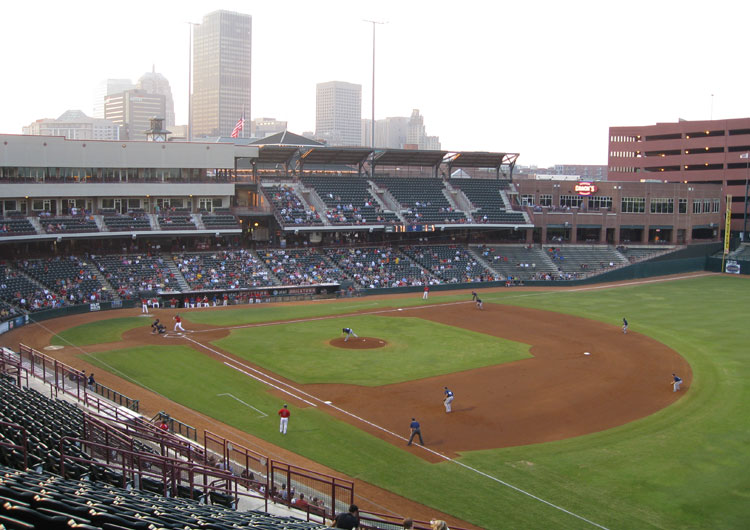
AT&T Bricktown Ballpark Facts, Figures & Footnotes
| |||||||||||||||||||||||||||||||||||||

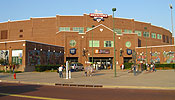

 No doubt, the most distinctive feature about the ballpark in Oklahoma City’s Bricktown is its stately exterior, but the best part about AT&T Bricktown Ballpark is the history that surrounds and adorns that notable brick-built exterior.
No doubt, the most distinctive feature about the ballpark in Oklahoma City’s Bricktown is its stately exterior, but the best part about AT&T Bricktown Ballpark is the history that surrounds and adorns that notable brick-built exterior.
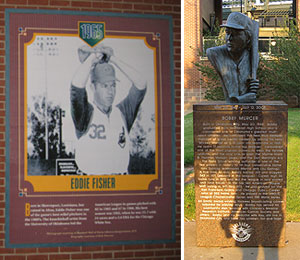 The links to the past continue inside of the ballpark, where numerous Oklahomans that played in the majors are remembered along the walls of the roomy concourse, which completely encircles and is open to the playing field. Players such as Jim Gentile and Eddie Fisher are shown in black and white photos, with captions detailing their connection to Oklahoma and careers in the big leagues written in white serif font below the photographs, which were provided by the Baseball Hall of Fame Library in Cooperstown.
The links to the past continue inside of the ballpark, where numerous Oklahomans that played in the majors are remembered along the walls of the roomy concourse, which completely encircles and is open to the playing field. Players such as Jim Gentile and Eddie Fisher are shown in black and white photos, with captions detailing their connection to Oklahoma and careers in the big leagues written in white serif font below the photographs, which were provided by the Baseball Hall of Fame Library in Cooperstown.
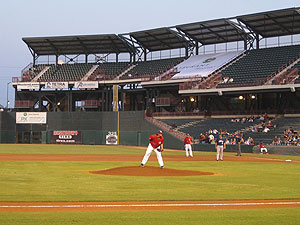 As for the upper deck, it’s a sizeable one, beginning half way down the left field line and wrapping all the way around the right field foul pole, although it’s broken into three distinct sections due to the detachment of the club level behind home plate.
As for the upper deck, it’s a sizeable one, beginning half way down the left field line and wrapping all the way around the right field foul pole, although it’s broken into three distinct sections due to the detachment of the club level behind home plate.
